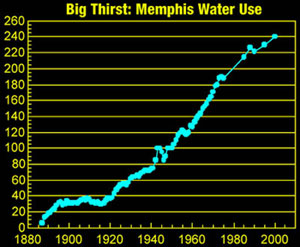Mississippi is seeking an injunction to stop the city of Memphis from pumping 60 million gallons of water per day from an aquifer. The state is also seeking is for several hundred million dollars in damages.
Mississippi Attorney General Jim Hood filed a lawsuit on Feb. 2 against both the city of Memphis and its utility company, Memphis Light Gas and Waterworks (MLGW), in U.S. District Court for the Northern District of Mississippi, Delta Division in Oxford. MLGW has been for many years taking massive quantities of Mississippis portion of the groundwater, says the suit. It seeks injunctive relief that would reduce MLGWs ground water consumption to approximately 140 mgd and would set the number as a ceiling. The suit sites the Mississippi River as a readily available alternative resource.
 |
| (Graph courtesy of Mike Bradley, USGS) |
Memphis currently draws drinking water exclusively from the highly pure Memphis Sand Aquifer. �The only filtration required is an aeration that eliminates dissolved gasses and causes dissolved iron to change to easily removed rust,� says Jerry Anderson, director of the Ground Water Institute, University of Memphis.
Mississippi is seeking an injunction to stop the city of Memphis from pumping 60 million gallons of water per day from an aquifer. The state is also seeking several hundred million dollars in damages.
Cones of depression created by the massive removal of water lie at the heart of the states argument. As water is pumped, pressure is lost, causing the depressed areas. Mississippi contends that excessive pumping has changed the natural flow of the water and is siphoning water from Northern Mississippi into Memphis. The issue is clouded, though, because the water appears to naturally flow from the southeast to the northwest, says Anderson.
MLGWs attorney disagrees. Our use of the aquifer does not create any liability to the state of Mississippi, says General Council Max Williams.
If Mississippi wins the suit, Memphis would be forced to turn to the Mississippi River as a source to meet the newfound shortfall and any future growth in demand.
A 60-million-gallon plant would cost between $90 million and $130 million, says Donald Thompson, vice president, Camp Dresser & McKee Inc, Cambridge, Mass. In addition to the initial cost of construction, the river plant would cost between two and four times more to operate than a comparable ground water aeration facility. The increased operating cost stems from a variety of new challenges, including stricter surface water regulations. A river plant would require the construction of new intake wells and coagulation filtration technology to deal with turbidity created by heavy seasonal rainfall. Organic materials also must be removed because they react with chlorine to form trihalomethanes and haloacetic acids. A great deal of thought must be given to treatment technology because of the wastewaters and agricultural run-off that the river collects, says Thompson.
Regardless of liability issues, there are concerns about the health of the massive aquifer system. The Memphis Sand Aquifer is part of a much larger water system known as the Mississippi Embayment, which stretches from southern Illinois to Texas and Alabama.
In recent years hexavalent chromium was found at some water pumping stations in the Memphis area. The contamination is an indicator of the sensitivity of how the aquifer system works, say Ted Fox, director of public works, Shelby Co., Tenn.
The chromium originated from a Superfund site at the Smalley-Piper tools plant in Collierville, Tenn., an outlying suburb of Memphis. The spread of the contamination was greatly accelerated by the pumping in nearby areas, says the Ground Water Institutes Anderson. One water pump has been permanently shut down and two others were temporarily shut down. They have since been reactivated but with a monitoring system that automatically stops pumping whenever chromium is detected.
The Memphis Sand Aquifer was thought to be protected from such contamination by a protective layer of clay. Recent studies have found that there are windows and thin areas in clay, says Anderson. These areas are possible sources of contamination, says Anderson.
Troubling findings were not limited to contamination, though. In areas where we expected the water to be thousands of years old, we are finding that it is only ten or twenty years old, says Anderson.
The ecological impact of the widespread pumping of water from the system and the effect of development on its widespread recharge basin is not well understood. The states of Tennessee, Arkansas and the Ground Water Institute, among others, are seeking $10.6 million from Congress to fund a study of the embayment.

Post a comment to this article
Report Abusive Comment